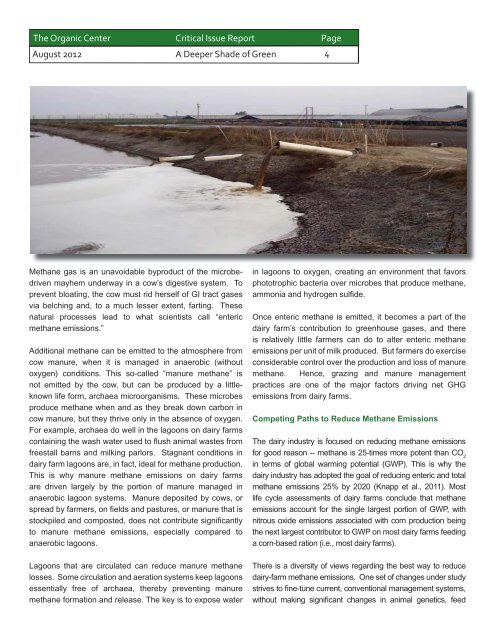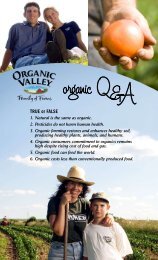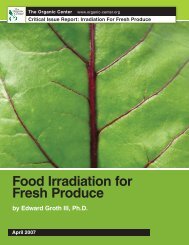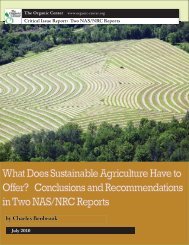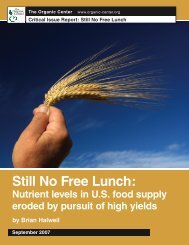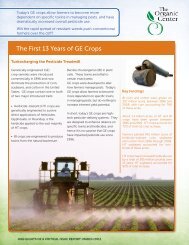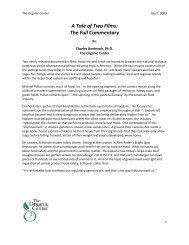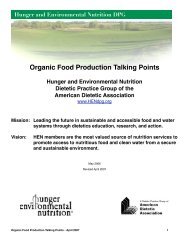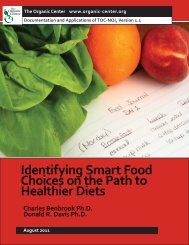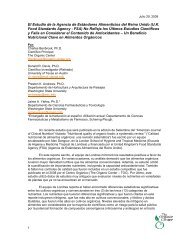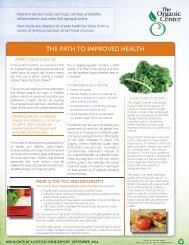Full Report - The Organic Center
Full Report - The Organic Center
Full Report - The Organic Center
Create successful ePaper yourself
Turn your PDF publications into a flip-book with our unique Google optimized e-Paper software.
<strong>The</strong> <strong>Organic</strong> <strong>Center</strong> Critical Issue <strong>Report</strong> Page<br />
August 2012 A Deeper Shade of Green 4<br />
Methane gas is an unavoidable byproduct of the microbedriven<br />
mayhem underway in a cow’s digestive system. To<br />
prevent bloating, the cow must rid herself of GI tract gases<br />
via belching and, to a much lesser extent, farting. <strong>The</strong>se<br />
natural processes lead to what scientists call “enteric<br />
methane emissions.”<br />
Additional methane can be emitted to the atmosphere from<br />
cow manure, when it is managed in anaerobic (without<br />
oxygen) conditions. This so-called “manure methane” is<br />
not emitted by the cow, but can be produced by a littleknown<br />
life form, archaea microorganisms. <strong>The</strong>se microbes<br />
produce methane when and as they break down carbon in<br />
cow manure, but they thrive only in the absence of oxygen.<br />
For example, archaea do well in the lagoons on dairy farms<br />
containing the wash water used to fl ush animal wastes from<br />
freestall barns and milking parlors. Stagnant conditions in<br />
dairy farm lagoons are, in fact, ideal for methane production.<br />
This is why manure methane emissions on dairy farms<br />
are driven largely by the portion of manure managed in<br />
anaerobic lagoon systems. Manure deposited by cows, or<br />
spread by farmers, on fi elds and pastures, or manure that is<br />
stockpiled and composted, does not contribute signifi cantly<br />
to manure methane emissions, especially compared to<br />
anaerobic lagoons.<br />
Lagoons that are circulated can reduce manure methane<br />
losses. Some circulation and aeration systems keep lagoons<br />
essentially free of archaea, thereby preventing manure<br />
methane formation and release. <strong>The</strong> key is to expose water<br />
in lagoons to oxygen, creating an environment that favors<br />
phototrophic bacteria over microbes that produce methane,<br />
ammonia and hydrogen sulfi de.<br />
Once enteric methane is emitted, it becomes a part of the<br />
dairy farm’s contribution to greenhouse gases, and there<br />
is relatively little farmers can do to alter enteric methane<br />
emissions per unit of milk produced. But farmers do exercise<br />
considerable control over the production and loss of manure<br />
methane. Hence, grazing and manure management<br />
practices are one of the major factors driving net GHG<br />
emissions from dairy farms.<br />
Competing Paths to Reduce Methane Emissions<br />
<strong>The</strong> dairy industry is focused on reducing methane emissions<br />
for good reason -- methane is 25-times more potent than CO 2<br />
in terms of global warming potential (GWP). This is why the<br />
dairy industry has adopted the goal of reducing enteric and total<br />
methane emissions 25% by 2020 (Knapp et al., 2011). Most<br />
life cycle assessments of dairy farms conclude that methane<br />
emissions account for the single largest portion of GWP, with<br />
nitrous oxide emissions associated with corn production being<br />
the next largest contributor to GWP on most dairy farms feeding<br />
a corn-based ration (i.e., most dairy farms).<br />
<strong>The</strong>re is a diversity of views regarding the best way to reduce<br />
dairy-farm methane emissions. One set of changes under study<br />
strives to fine-tune current, conventional management systems,<br />
without making significant changes in animal genetics, feed


